Share This
Every year the NRA (that’s the National Restaurant Association – not the guns one) holds its annual convention in Chicago in May. With nearly 2,000 exhibitors and upwards of 60,000 people, it’s an enormous show. My job was to see and taste it all, in three days. In today’s blog, I’ll share the whole grain highlights with you.
One theme that was very evident on the show floor was an increasing attention to different and less common grains. At past shows, whole wheat bread and brown rice were perhaps the most obvious torchbearers for whole grains. We love ‘em both, but what a delight to see more whole grains represented, in more different forms.
American Roland, for example, was sampling a delicious warm savory dish of Marinated Mushrooms and Einkorn Wheat with sherry vinegar, shallots, herbs and extra virgin olive oil. That’s culinary student Melissa Wunderlich serving up tastes, above. Linda Young, a spokesperson for American Roland, said that in addition to einkorn, kañiwa, a cousin of quinoa that’s sometimes described as “baby quinoa” is also taking off in popularity.
Other grains that most restaurants had never heard of until recently were also in evidence at the show. Katie Chambers (above) of Stahlbush Island Farm was giving away samples of a number of different grains and legumes, including a delicious black barley. Stahlbush sells their products in IQF (individually quick frozen) form, making it easy for restaurants to warm and serve portions as needed. Nearby, another booth displayed samples of the teff, amaranth and sorghum in their products, for those who may never have seen those three grains.
Oatmeal’s not the only good choice for breakfast anymore, either. Look closely above, and you’ll see that a company named Wild Veggie (love the name!) was offering heat-and-serve cereal bowls that combined quinoa with oatmeal (and with pearl barley – which is not a whole grain but still a good food). Not far away, Earnest Eats mixed both quinoa and amaranth with their oatmeal.
We checked in with Debbie Wheeler, Test Kitchen Manager at Riviana, and sampled a delicious wild rice salad with almonds and cranberries, then stopped by Bob’s Red Mill to visit with Tim Steiner and Tony Castaneda. Tony said millet’s taking off in sales and interest now, as customers explore alternatives to quinoa with its higher prices.
That last picture above is whole wheat Asian noodles, from a company called Passport, which illustrates another trend too: the influence of new U.S. school rules on new products. By July 1, 2014 – yes, just a month away — virtually all grain foods offered in schools must contain more whole grain than refined grain, and it was clear at the NRA show that companies are gearing up for this market. We expect the products they come up with will quickly spread into other areas of foodservice.
We also enjoyed seeing whole grains positioned as premium and artisan at the NRA show. We were drawn to the CH Guenther booth by their proud use of the Whole Grain Stamp in their display (above). While I munched on a sample of their new oat bars, I asked where the bars were being sold. They’re not in retail, I learned: they were custom-produced for a major hotel chain, that puts them on guests’ pillows at turn-down time. Very cool. Tuck me in, and hand me an oat bar.
If anyone foolishly assumed that all these whole grains were some new invention, the folks in the Lithuania booth were there to remind everyone that whole grains are a revered tradition in cultures around the world, with some great rye bread. Longtime WGC members Paul and Joan Rubschlager were offering a similar traditional rye bread in their booth – baked right in Chicago; no need to travel to Scandinavia or the Baltics.
Which food rivals whole grains in popularity these days? Greek yogurt of course. Chobani is now combining these two uber-popular trends by adding oats to their Greek yogurt.
By now, my feet were about ready to fall off. Wish I’d worn a pedometer to record how many miles I trekked in three separate halls. (The good news about all that walking? I didn’t gain a pound from all the noshing!) It was time to take a break from the show floor, and put on a special WGC show of our own.
This year the NRA added a new feature called “Foodamental” sessions to the show. These were designed to be hands-on sessions, where chefs and other foodservice personnel could do more than simply see or taste – they could roll up their sleeves and do something. One session experimented with pickling. In another, a butcher taught how to carve up a joint of beef. The Whole Grains Council was invited to come up with a session that would make whole grains come alive for restaurateurs, in the enormous “Foodamental Studio.
We called on Chef Mike Holleman, Director of Culinary Development for InHarvest and Chair of the WGC Advisory Board, and together came up with a fun grain-tasting plan. First, we would give our attendees twelve difference grains to sample. Then, Mike would demo the creation of a Greenwheat Freekeh® and Massaged Kale Salad (see recipe here). Finally, we would divide the class into four groups, each of which would create its own delicious whole grain salad.
Fortunately, NRA Show staff arranged for culinary students at Kendall College to help with prep and cleanup for the event. As per our instructions, they cooked off forty pounds of whole grains: black and white barley; red, white and black quinoa; red and black rice; wild rice; and four kinds of wheat: bulgur, wheatberries, freekeh, and Kamut® khorasan wheat. And here’s how it all went down:
The grains arrived backstage in big trays, and the culinary students quickly filled 50 cups with each of our 12 grains.
Before long, there were cups of grains pretty much as far as the eye could see, in our backstage area.
Next step: assemble a set of all 12 grains for each of our participants.
Then, deliver a little sampling tray of grains to each place at the worktables, with a description of each grin, a WGC brochure about whole grains, and a copy of the recipe Mike would be demo’ing.
Our culinary apprentices also set up four Salad Stations around the Foodamental Studio: an Asian Station (black and white barley, Asian dressing, mangos, scallions, cilantro, cabbage, etc.), a Mediterranean Station (Kamut® and freekeh, Mediterranean dressing, sun-dried tomatoes, olives, mint, oregano, feta, etc,), a Latin Station (black and red quinoa, Latin dressing, black beans, tomato, avocado, etc.) and a Local/Regional Station (red and wild rice, herb vinaigrette dressing, asparagus, peppers, zucchini, etc.)
(Later, in the last part of our class, participants chose a station, and worked together to make salads, while comparing how each of their two grains changed the taste profile of the salad.)
Last photo. It’s almost show-time, and Mike’s setting up his demo on the stage, above. Note the closeup of the WGC logo on his chef’s jacket. Go Whole Grains Council!
The class was a great success. Clearly, we opened a lot of eyes to the wonderful variety of tastes, textures and colors that are available in the world of whole grains. We hope that the success of this show will make it easier for everyone reading this blog to find more whole grain choices when eating out. (Cynthia)

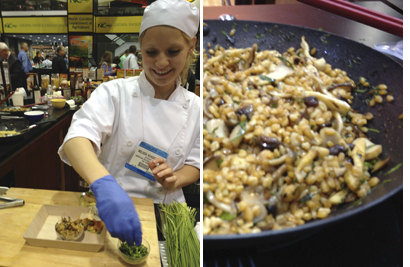
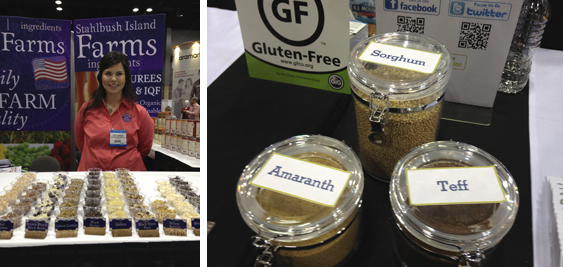
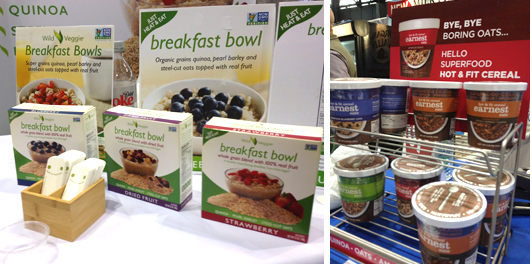
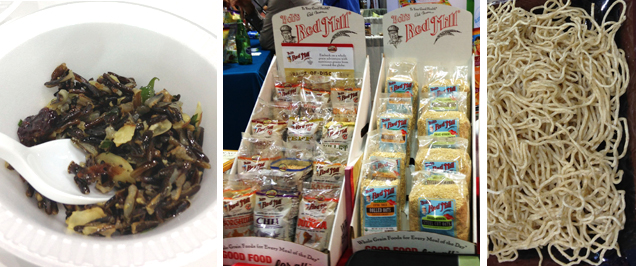
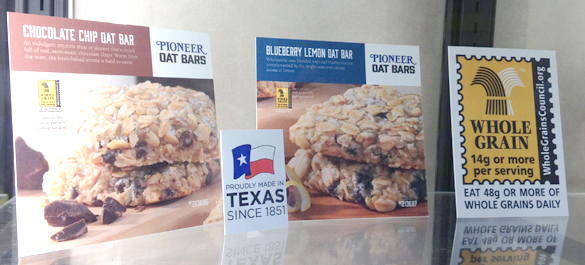
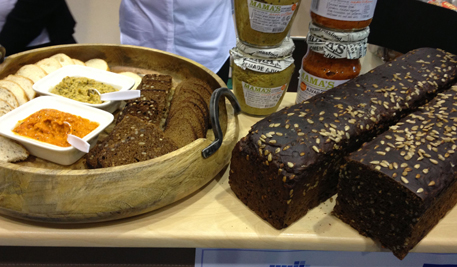
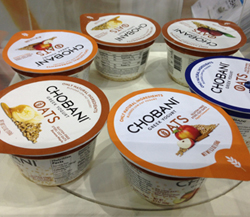
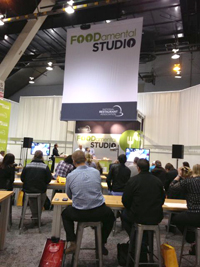
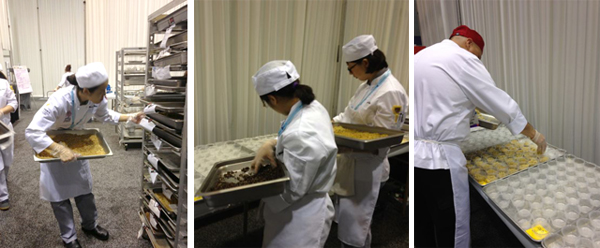
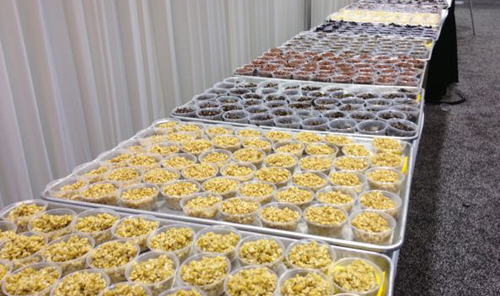
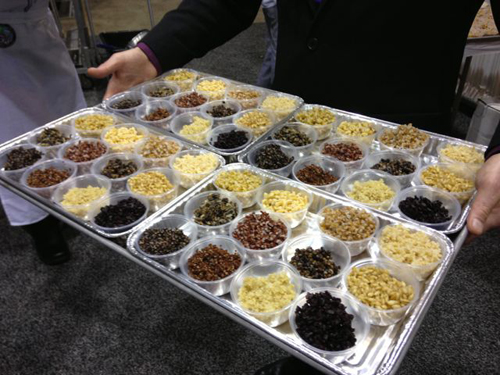
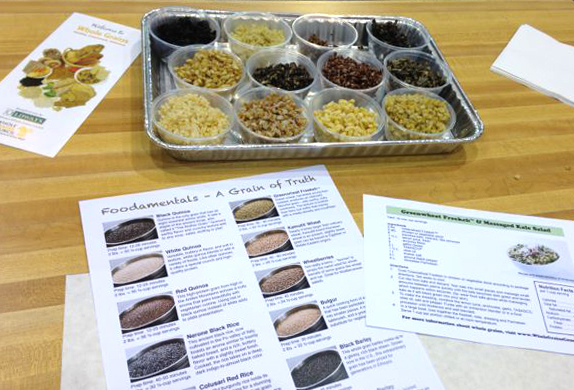
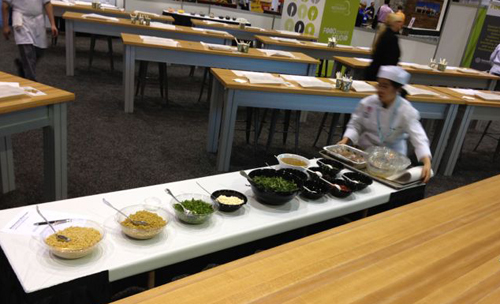
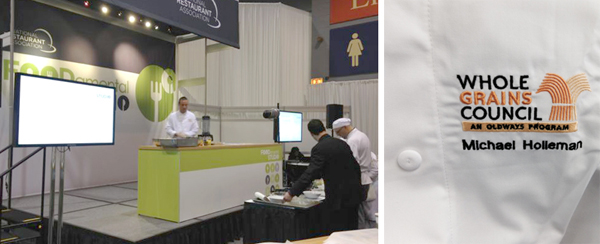
Add a Comment